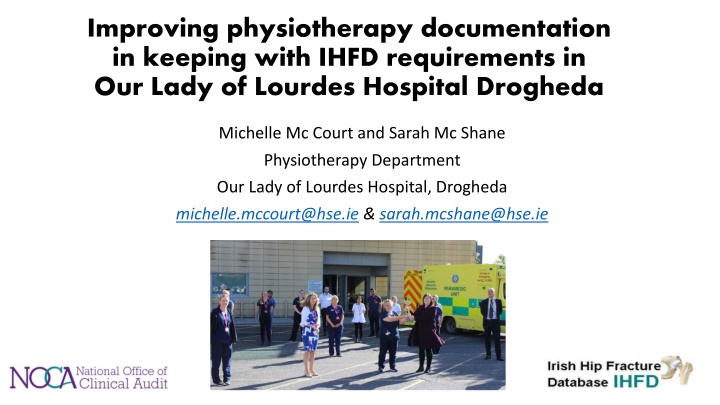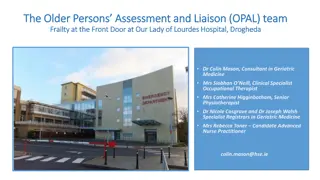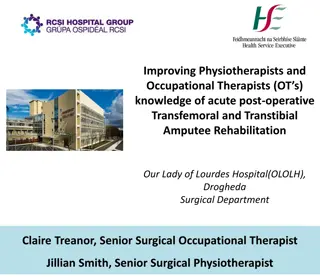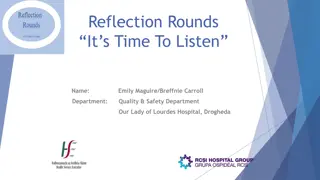Enhancing Physiotherapy Documentation for IHFD Compliance at Our Lady of Lourdes Hospital
The project focused on improving physiotherapy documentation for hip fracture patients in alignment with IHFD requirements at Our Lady of Lourdes Hospital, resulting in a significant increase in compliance after competency training.
Download Presentation

Please find below an Image/Link to download the presentation.
The content on the website is provided AS IS for your information and personal use only. It may not be sold, licensed, or shared on other websites without obtaining consent from the author.If you encounter any issues during the download, it is possible that the publisher has removed the file from their server.
You are allowed to download the files provided on this website for personal or commercial use, subject to the condition that they are used lawfully. All files are the property of their respective owners.
The content on the website is provided AS IS for your information and personal use only. It may not be sold, licensed, or shared on other websites without obtaining consent from the author.
E N D
Presentation Transcript
Improving physiotherapy documentation in keeping with IHFD requirements in Our Lady of Lourdes Hospital Drogheda Michelle Mc Court and Sarah Mc Shane Physiotherapy Department Our Lady of Lourdes Hospital, Drogheda michelle.mccourt@hse.ie & sarah.mcshane@hse.ie
Background: The Irish Hip Fracture Database (IHFD) started as collaboration between Irish Gerontology Society & Irish Institute for Trauma & Orthopaedic Surgery, operating under the governance of NOCA, since 2013. It comprises of a yearly audit, collecting high-quality data on hip fractures in Ireland. 6 Hip fracture standards were developed in 2018, with a new standard introduced in 2020. Hospitals aim to achieve all these standards for every hip fracture patients presenting to their site. The 7th standard introduced in 2020 focused on physiotherapy best practise. This new standard states that all patients should be seen by a physiotherapist within 24 hours of surgery and ideally mobilised. Mobilisation at the earliest possible stage in hip fracture patients is a key measure of care and has been linked to better outcomes for the patients, specifically delirium resolution/prevention, prevention of bone health loss and prevention of sacropenia. It is important all information on the physiotherapy intervention provided within the initial 24 hours post-operative period is documented clearly in the patient s chart, clearly noting the outcome measures as required by the IHFD, namely the cumulative ambulatory score (CAS) and new mobility score (NMS). In the instance that a patient isn t mobilised in their acute 24 hour post-operative period, the reason for being unable to mobilise should also be recorded. Aim: The aim of this project was to establish the adherence of completion of necessary documentation for hip fracture patients who were reviewed by the weekend physiotherapy service in OLOL, in keeping with the IHFD requirements.
Results: An audit was completed to establish baseline adherence levels and establish what, if any, areas of improvement were needed to be addressed. From this preliminary audit it was noted that only 40% of the necessary documentation was being completed by the weekend physiotherapy service. It was decided that the best way to improve this documentation adherence was to run competency training for all the physiotherapy staff listed on the weekend rota, with emphasis placed on the importance of accurate and complete documentation. This was provided over a two week period by the orthopedic physiotherapists and captured over 80% of the physiotherapists on the weekend service. A follow up audit was then completed to establish if there was any change in practice, which highlighted that after the competency training there was 100% compliance with completion of the necessary documentation. The audit was completed over a ten weeks period post the competency training to ensure that the improvements were maintained. Conclusions: This QI project was successful in achieving its aim as it identified a problem, implemented a action strategy and achieved the desired solution. The knowledge gained from this project will also assist in improving future orthopaedic training sessions, which must be completed by all staff on the weekend service annually. Lastly, this project has improved orthopaedic physiotherapy caseload post weekends, as there is less time spent reviewing charts to complete the necessary outcome measures, required by the IHFD, retrospectively. Dubljanin-Raspopovi , E., Markovi -Deni , L., Marinkovi , J., Nedeljkovi , U., & Bumba irevi , M. (2013). Does early functional outcome predict 1-year mortality in elderly patients with hip fracture?. Clinical orthopaedics and related research, 471(8), 2703 2710. https://doi.org/10.1007/s11999-013-2955-1























